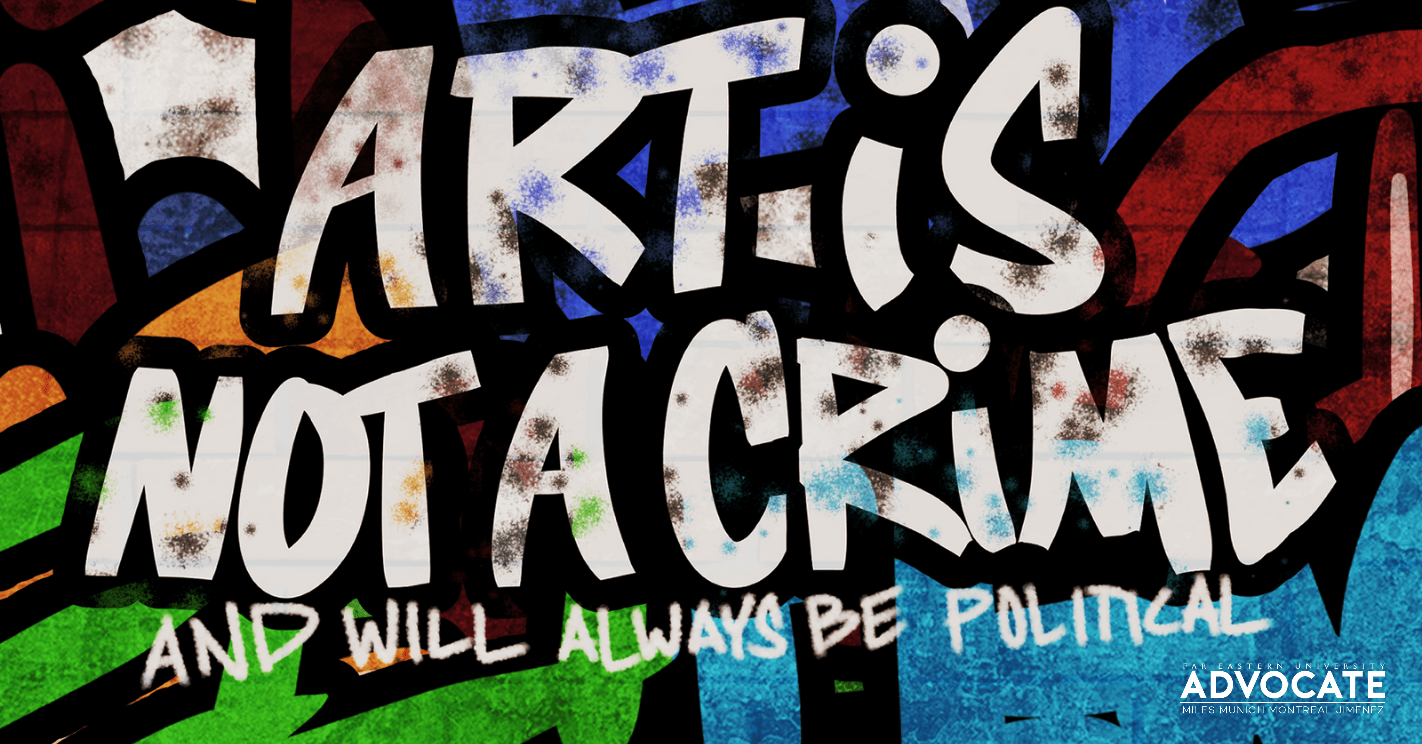
Devosora delivers 14 points despite loss to UST
- March 01, 2023 09:00
FEU Advocate
April 30, 2021 13:20

Traditional jeepneys are perceived and tagged as the Philippines’ Kings of the Road, but their prevailing repute is now threatened to be gone with the looming odds of modernization.
Modernization in transportation certainly has a nice ring to it, but these changes had to come at the expense of jeepney phaseout. This means that in no time, modernized jeepneys will dominate the streets, while outdated Public Utility Jeepneys (PUJs) will be eliminated because they are considered old, poorly maintained, prone to accidents, and in the long run would heighten the rate of pollution.
Therefore, the traditional jeepneys that have been a significant part of our lives and culture are about to be replaced. The primary reasons for our arrival at many of our most important destinations are nearing their final stop. But in the face of anticipated jeepney phaseout, our drivers and operators refuse to be left behind.
Paving the way to modernization
The initiative to revolutionize the public land transportation industry began in June 2017 when the Department of Transportation (DOTr) issued Department Order (DO) No. 2017-11, “Omnibus Guidelines on the Planning and Identification of Public Road Transportation Services and Franchise Issuance,” also known as the Public Utility Vehicle Modernization Program (PUVMP) under President Rodrigo Duterte’s administration.
Land Transportation Franchising and Regulatory Board (LTFRB) led its three-point implementation which concerns replacing the existing franchising system by means of Consolidation Program; bringing Public Utility Vehicles (PUVs) up to international standards with the help of Fleet Management System; and giving a mandatory professional training through the Driver’s Academy.
To explain briefly how the PUVMP will be enforced, the consolidated units will be under an accredited cooperative or corporation which can operate up to 15 vehicles to facilitate the issuance of franchises, and attain a uniform transport industry. Its purpose is also to put operators and drivers in one legal entity to systematically purchase new vehicles from international manufacturers in compliance with LTFRB’s guidelines. On the other hand, route rationalization will be managed by Local Government Units (LGUs) through their Local Public Transport Plan (LPTRP) to ensure a dependable mode of transportation for their constituents.
The jeepney modernization sees to reduce pollution, improve safety and punctuality, offer comfort, and change the overlapping routes that cause the exhausting traffic congestion in the country.
However, the expenses that entail such modernization do not come cheap. As stated in the jeepney phaseout primer of Pinagkaisang Samahan ng Tsuper at Opereytor Nationwide (PISTON), an Electric Jeep (E-jeep) costs P800,000 to P1.2 million; Euro 4 Engine’s price is P1 million to P1.5 million; and the value of a Solar Powered Engine reaches up to P1.6 million. Even if the DOTr were to increase the equity subsidy to P160,000 per unit, it would still not suffice. Also, the Landbank of the Philippines (LBP) and the Development Bank of the Philippines (DBP) who will assist the cooperatives in need of funds will charge an annual interest rate of 6%, with 5% equity of P80,000 that they are obligated to pay for seven years.
The cost of modernized jeepneys would amount to P1.3 to P2.4 million per unit with its additional features, plus the interests from the bank loan that they would incur. This is clearly too much for their low income considering how they can barely supply their own sustenance with the burden added by the Coronavirus Disease 2019 (COVID-19) pandemic. Since the pandemic started, we have seen many jeepney drivers and single operators begging on the streets to ask for monetary help and donations. This sparked debates on whether or not the PUVMP is anti-poor because it seems like its ‘comprehensive system reform’ is out of touch with reality.
Shifting paths
The possibility of jeepney phaseout together with the impact of the COVID-19 pandemic filled our Filipino drivers and operators with uncertainty as they struggled to save their crippling livelihood. According to the LTFRB, there are about 74,000 PUJs in Metro Manila, representing nearly 150,000 drivers and 50,000 operators of jeepneys.
Nolan Grulla, 56, a traditional jeepney driver for 21 years who used to ply the route of University of the Philippines (UP) Diliman Campus to SM North, admitted that the income was good back then until the lockdown period halted their job. “Ang kinikita ko ay P1,200 pesos kasi malakas ang byahe namin, nung nagka pandemya ay swerte makapag-uwi ka ng P200 (My income is P1,200 [before] because our trip was strong, when the pandemic started I was lucky to be able to take home P200),” he said.
In an interview with FEU Advocate, Mody Floranda, President of PISTON, expressed that although they have returned to the road, their income is still inadequate and unable to cover bills and other necessities due to the high price of commodities amid this pandemic.
Facing this crisis without a stable source of income forced these jeepney drivers to find other ways to survive like entering sidelines and selling their PUJ unit or its scrapped parts. Their everyday life worsened considering that it has been more than a year without proper travel, and many families of drivers and operators were impelled to live in their jeepneys because of the inability to pay their rent.
Jouie Abarquez, a 49-year-old jeepney driver for 19 years and who used to brave the route of Pasay Road to Alabang, shared that if his family did not have their own home, they would be starving in quarantine. “Tatlo anak ko, special child ang panganay ko na lalaki, dalawang babae… kahit bawal magbyahe ng habal-habal, nagbyahe na lang ako habang pandemic at wala pang byahe jeep. Medyo naka-survive naman kahit nag-maintenance ako ng gamot pati yung anak ko na panganay (I have three children, my eldest son is a special child, [and] two girls… even though it is forbidden to drive habal-habal, I still did during the pandemic and jeeps are not allowed yet. We kind of survived even if I did maintenance medications and my eldest son as well),” Abarquez opened up.
Resisting the highway
March 31, 2021 was the deadline given by LTFRB to comply with the consolidation requirements that is prerequisite for the PUVMP. Although LTFRB Chief Martin Delgra said that those who have not met the deadline still have a chance to pass within the current year, there is still no assurance that our drivers and small operators will survive the potential jeepney phaseout.
With the fatal impact of the COVID-19 pandemic, jeepney modernization is pushing out the lives of local drivers and operators to the side which then urges them to oppose the project.
“Ang laban namin sa phaseout ng PUV ay umabot sa limang taon… Kami ay hindi tutol sa modernisasyon ng mga PUV, ang nilalaban namin dito ay 'yung eksena ng LTFRB na bakit kami sapilitang pinapapasok sa konsolidasyon at monopolyo sa transportasyon. Matagal na po kami nanghihingi ng rehabilitasyon ng mga jeep, wala pa mang plano ang pamahalaan (Our fight against the phaseout of the PUV has lasted for five years… We are not against the modernization of the PUVs, what we are fighting against here is the LTFRB scene on why we are coerced into the consolidation and transportation monopoly. We have been asking for rehabilitation of jeeps even when the government has no plans [for the modernization] yet),” PISTON President Floranda clarified.
The resistance for the jeepney modernization is not rooted in their rejection for change. Drivers and operators have been waiting for improvement for a long time, but the steps that the government is taking are coming off as hasty and insistent which is why many are skeptical about it.
Floranda also said that if the government wants a good mode of transportation, the country must build a local vehicle industry so that we can manufacture our own jeepneys and not have to depend on other countries.
Avenue of consequences
In line with PISTON’s primer, approximately 500,000 drivers, 300,000 operators, and two million families will be affected by jeepney phaseout in the Philippines. These individuals lack the privilege to pay for the modern jeeps due to their standing in life. Many will be left behind trying to keep up with the modernization program.
Aside from the financial problems it will bear, timing is also a relevant aspect for the drivers and operators’ stance about the PUVMP. Both Grulla and Abarquez stated that the program should not push through during these trying times of public health crisis. The COVID-19 pandemic has already resulted in severe unemployment woes, and jeepney phaseout will add to the growing number of jobless Filipinos in the country.
“Maraming mawawalan ng trabaho na driver at ‘di rin basta makakahanap ng ibang trabaho kasi mga overage na. Kaya kung tutuusin, sa mga tradisyunal na jeep pa rin kami kasi wala naman na makakakuha kasi mahal at wala sa kalahati ang kikitain namin kaysa sa dati (Many drivers will lose work and they will not be able to find other jobs because they are overage. In fact, we still prefer traditional jeeps because no one can afford [E-jeep] for it is expensive and we will not earn half as much as before,” Abarquez pointed out.
The lockdown period is causing tension for the transport sector because it limits their already restricted routes, making their earnings more unstable than ever. “Ibigay ‘yung hinihingi namin na ayuda na hanggang ngayon wala kami nakukuha sa gobyerno (Give us the help we are asking for that we have not received from the government so far),” Grulla stressed.
At the same time, jeepney modernization will also agitate ordinary commuters. Fare increase is inevitable in the middle of a pandemic where many are impoverished. Common citizens that rely on PUJs will seriously be affected with the spike of payment because most are victims of contractualization. “Hindi rin kakayanin ng mamamayan lalo na sa kalagayan na mababa ang sahod dito sa NCR na umaabot lamang ng P537 kada araw ang sahod, at ‘di hamak na mas mababa ang sahod ng mga manggagawa sa labas ng NCR (The Filipino people will not be able to afford it either especially in the situation of low wages here in the NCR [National Capital Region] which is only P537 a day, and the income of workers outside the NCR are much lower),” Floranda explained.
Fighting the road to modernization
Drivers like Floranda, Grulla, and Abarquez represent the agony of jeepney drivers and operators today. Their message to the government is to terminate jeepney phaseout because it will bring more difficulty especially with the COVID-19 pandemic.
Although the filing of application for the consolidation program is still ongoing up to the end of this year, the determination of our jeepney drivers and operators to defend their place in the society will continue to persist.
With the aim to extend their position regarding the seemingly abrupt jeepney modernization, Floranda emphasized that they are committed to amplify their voices through strikes and fight for their rights to prevent the looming displacement, “Ang panawagan namin sa Pangulo ay ibasura ang DO 2017-11, at payagan kami na makabalik sa aming hanap-buhay at pagseserbisyo sa mamamayan… Isabansa ang transportasyon, ipatupad ang tunay na reporma sa lupa at industriya sa ating bansa, at ibasura ang PUV phaseout (Our call for the President is to repeal DO 2017-11, and allow us to return to our jobs and service to the people… Nationalize transportation, implement genuine land reform and industry in our country, and junk the PUV phaseout.”
As the government focuses on reviving the economy amid the pandemic, the transition to jeepney modernization puts the livelihood of small jeepney drivers and operators at stake. We must educate others about their plight to spread consciousness towards their struggle for it affects us all too. In addition, signing the online petition initiated by PISTON to allow jeepneys and other PUVs to operate again is a great help. Let us heed their calls by championing their rights and supporting their relentless fight against jeepney phaseout because they do not deserve to be left behind.
-Maria Leonora Z. Roja









